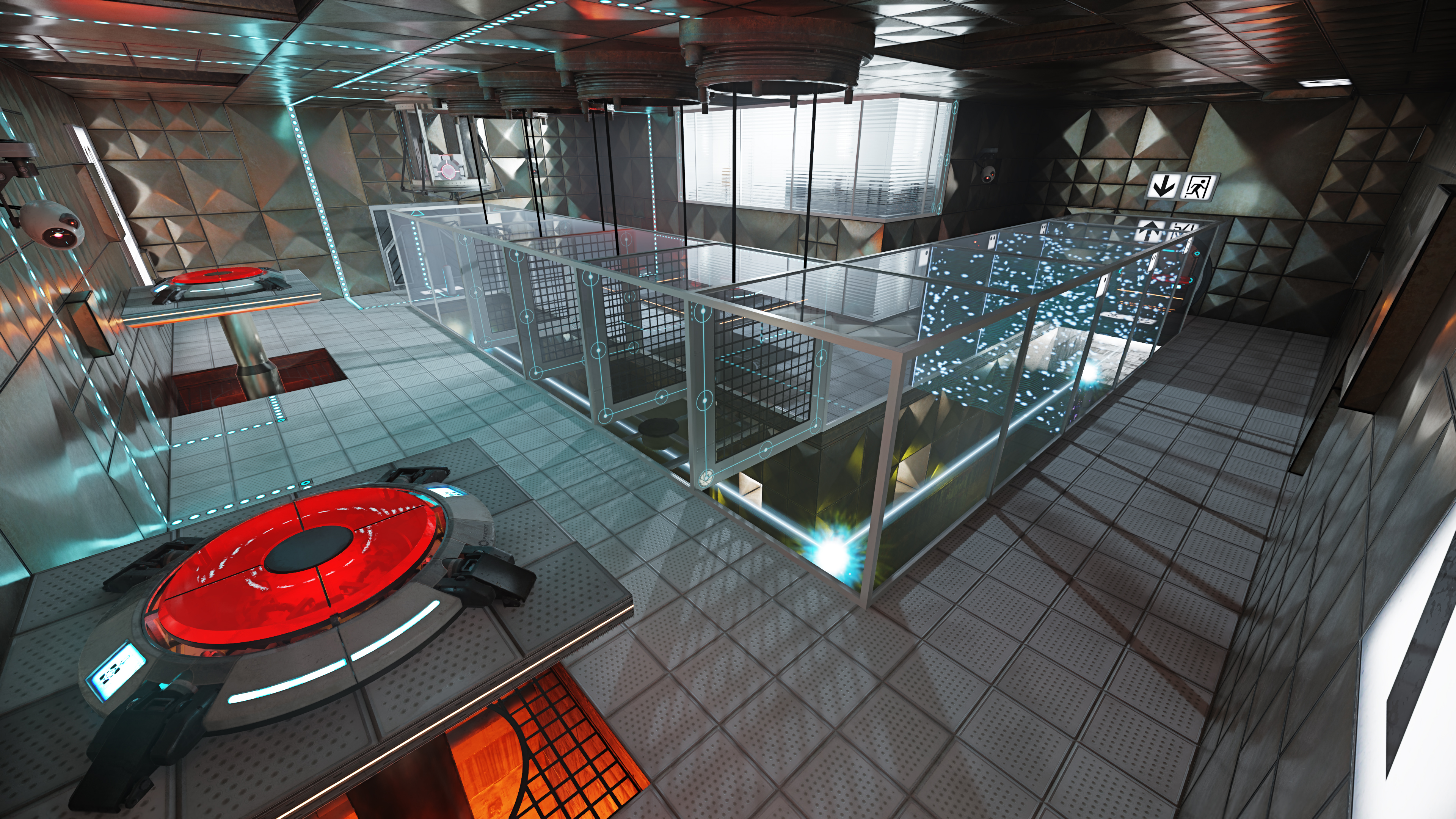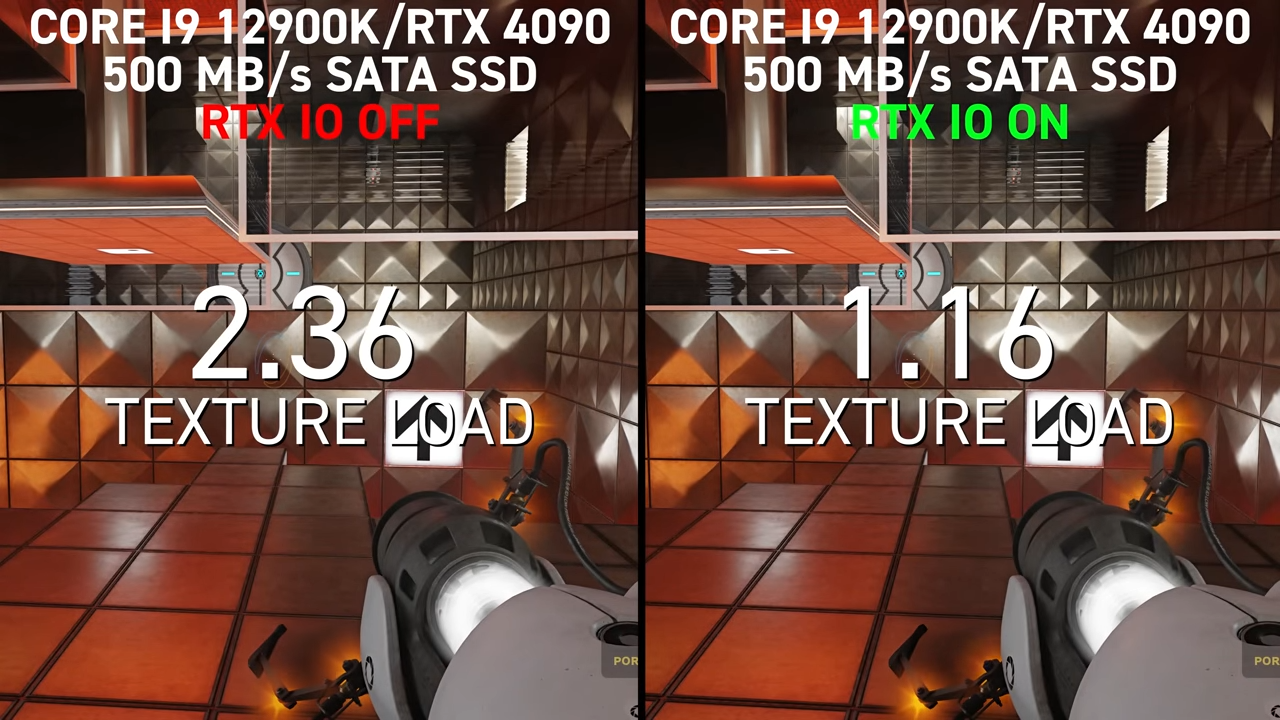Portal: Prelude RTX Loads 50% Faster Thanks to RTX IO GPU Decompression
The first game to feature new GPU decompression tech, which boosts game loading times.

Digital Foundry recently took a sneak peek at Nvidia's new RTX IO GPU decompression technology in Portal: Prelude RTX, and found the tech can seriously improve game load times with modern SSD hardware. The game review outlet found that Nvidia's new storage-enhancing tech cut loading times in half, drastically accelerating the wait time for both game levels and high-resolution textures found in the game.
RTX IO is a new method of uploading game information to your graphics card, that reduces game loading times and decreases CPU utilization. Instead of transferring data to the CPU for decompression, RTX IO's GPU decompression transfers all game assets from storage to the GPU, where the GPU cores decompress the data at a significantly faster pace.
RTX IO is a term that Nvidia coined to comprise several technologies for GPU-based loading and asset decompression. In actuality, RTX IO is based on GDeflate, an open-source compression format Nvidia created that is supported by Microsoft's DirectStorage API, and Vulkan — with two new Nvidia Vulkan extensions. As a result, you don't need an Nvidia GPU to run RTX IO necessarily. All you need is a GPU that supports DirectStorage or Nvidia's new Vulkan extensions to run it.
In testing, Digital Foundry found that RTX IO was able to improve load time performance by roughly 50% in Portal: Prelude RTX. Testing was conducted on a Core i9-12900K and an RTX 4090, with the game stored on a 500MB/s SATA 3 SSD. With RTX IO disabled (featuring a specialized test build of the game), the game was able to load in 2.36 seconds. But by turning RTX IO on, the game was able to load everything in just 1.16 seconds — including the test chamber and the high-resolution textures.

In further testing with Gen 3 NVMe SSDs, the review outlet found that RTX IO was able to boost load time performance by an additional 90ms beyond what the SATA 3 drive was able to achieve. Additionally, RTX IO was also able to turbocharge the SATA 3 drive, making the slower SSD faster than the NVMe drive with RTX IO enabled (and RTX IO disabled on the NVMe drive).
Sub-three-second loading times are plenty fast for any video game, but from a benchmarking perspective. Cutting an extra second off of the load time is very impressive and a good demonstration of RTX IO's capabilities. It also improves the capabilities of any storage drive, whether or not you have the Best SSDs in your system.
This is just a glimpse of the capabilities can expect from RTX IO GPU decompression. Portal: Prelude RTX is a mod of a mod based on a game created 15 years ago, so there's no real-world benefit from having RTX IO unless you really crave sub-3-second load times. Rachet and Clank: Rift Apart will be the first game to truly test RTX IO when it arrives next week, and will hopefully show substantially more tangible results with RTX IO, with its inter-dimensional gameplay demanding instantaneous asset streaming.
Get Tom's Hardware's best news and in-depth reviews, straight to your inbox.

Aaron Klotz is a contributing writer for Tom’s Hardware, covering news related to computer hardware such as CPUs, and graphics cards.
-
Alvar "Miles" Udell HotHardware did their own test and wrote about it, and noted issues with the specially modified non-RTX IO edition which uses uncompressed assets as opposed to the regular edition's compressed. They also noted the games horrendous performance, with DLSS 3.0 frame generation being required.Reply
Perhaps TomsHardware should do their own review instead of just watching a Youtube video and talking about it and see if the results can be duplicated?
https://hothardware.com/news/dlss-3-rtx-io-tested-portal-prelude-rtx
-
Sleepy_Hollowed Oooof, with a GTX 4090, call me when they do tests with 4060 and 4070, as that card does not even need that, and that's what they've been marketing as a "benefit" for a bit now.Reply
If this is only good on their top tier card, it's worthless. -
ManDaddio Reply
Does the graphics card matter? It should work the same on all GPUs that can run the respective resolution made for them.Sleepy_Hollowed said:Oooof, with a GTX 4090, call me when they do tests with 4060 and 4070, as that card does not even need that, and that's what they've been marketing as a "benefit" for a bit now.
If this is only good on their top tier card, it's worthless. -
ManDaddio Reply
Why would anyone test such low resolutions with a 4090? That alone makes the tests worthless. And why DLSS?Alvar Miles Udell said:HotHardware did their own test and wrote about it, and noted issues with the specially modified non-RTX IO edition which uses uncompressed assets as opposed to the regular edition's compressed. They also noted the games horrendous performance, with DLSS 3.0 frame generation being required.
Perhaps TomsHardware should do their own review instead of just watching a Youtube video and talking about it and see if the results can be duplicated?
https://hothardware.com/news/dlss-3-rtx-io-tested-portal-prelude-rtx
-
Sleepy_Hollowed Reply
Very much so, as they've been justifying their VRAM deficit this generation on lower tier cards with the compression tech they had yet to demonstrate.ManDaddio said:Does the graphics card matter? It should work the same on all GPUs that can run the respective resolution made for them. -
tamalero Reply
Did you check the performance graphics?ManDaddio said:Why would anyone test such low resolutions with a 4090? That alone makes the tests worthless. And why DLSS?
It seems the 4090 struggles to give playable performance even at 1080p unless you use DLSS and DLSS3 Frame Generation. -
neojack very impressive.Reply
Also the fact that it's a 4090 does not change anything. The point is to benchmark hadware deceompression from the GPU, even on the cheapest GPU, it will be mile ahead of software decompression done by the CPU
This could help for openworld VR games, where loading assets can lead to stutter and then induce a dizzy feeling. (looking at you, No Man Sky !) -
Kamen Rider Blade Reply
It's more of a indictment against Path Tracing and how much of a resource hog it is on such a old game.ManDaddio said:Why would anyone test such low resolutions with a 4090? That alone makes the tests worthless. And why DLSS?
With a RTX 4090 Mobile @ 1K-class resolutions (1280x800), you are getting 57 FPS Average with DLSS3 in the Off mode.
Think about that carefully and what it implies for what caliber of hardware for RT hardware.
If a RTX 4090 Mobile is "BARELY" good enough for 1K-class resolution to reach just a bit short of 60 FPS, imagine how much more powerful hardware you will need to reach 60 FPS for 2K-class, 3K-class, much less 4K-class. -
evdjj3j Reply
That's what the Tomshardware of 15-20 years ago would do, but not today.Alvar Miles Udell said:HotHardware did their own test and wrote about it, and noted issues with the specially modified non-RTX IO edition which uses uncompressed assets as opposed to the regular edition's compressed. They also noted the games horrendous performance, with DLSS 3.0 frame generation being required.
Perhaps TomsHardware should do their own review instead of just watching a Youtube video and talking about it and see if the results can be duplicated?
https://hothardware.com/news/dlss-3-rtx-io-tested-portal-prelude-rtx
-
evdjj3j Reply
Consider yourself called because they tested a 2060 super too.Sleepy_Hollowed said:Oooof, with a GTX 4090, call me when they do tests with 4060 and 4070, as that card does not even need that, and that's what they've been marketing as a "benefit" for a bit now.
If this is only good on their top tier card, it's worthless.